Class 10 Science Chapter 10 Question Answers - Human Eye and Colourful World
Q1: Define the term “accommodation of the eye”.
Ans: The ability of the eye to focus on near and distant objects by adjusting its focal length, is called the accommodation of the eye.
Q2: What is "persistence of vision" ?
Ans: Persistence of vision is the ability of the human eye to retain an image on the retina for a short time after the object is removed. It's about 1/16th of a second for the human eye.
Q3: Define “least distance of distinct vision”.
Ans: The smallest distance, at which the eye can see objects clearly without strain, is called the near point or the least distance of distinct vision. For a young adult with normal vision, it is about 25 cm."
Q4: How does the eye adjust its focal length?
Ans: The eye adjust its focal length by means of its ciliary muscles.
Q5: What is short sight? How can it be corrected?
Ans: If a person can see nearer objects clearly but not the far objects, then he is affected by short sight. It can be corrected using a suitable concave lens.
Q6: What property of the eye is the principle of motion, pictures?
Ans: Refraction of light through the eye lens is the basic principle for the visualization of pictures and motion.
Q7: What eye defect is myopia?
Ans: Myopia is also known as near-sightedness. A person with myopia can see nearby objects clearly but cannot see distant objects distinctly.
Q8: What are the causes of myopia (short-sight) ?
Ans: Myopia can be caused due to following reasons.
- Elongation of eyeball.
- Excessive curvature of eye lens.
Q9: What are the causes of hypermetropia (far-sight) ?
Ans: Hypermetropia can be caused due to following reasons.
- Shortening of eyeball.
- Focal length of eye lens becomes too long.
Q10: What is presbyopia? State the cause and corrective lens used.
Ans: Presbyopia is the gradual loss of your eyes' ability to focus on nearby objects. It is caused due to gradual weakening of ciliary muscles and diminishing flexibility of eye lens due to ageing. Presbyopia can be corrected by using bifocal lens.
Q11: A person having a myopic eye used the concave lens of focal length 50 m. What is the power of the lens?
Ans: The formula for the power of lens is Power (P) = 1/f.
P = 1/50 = 0.02 dioptre.
Q12: Draw well labelled diagram of human eye.
Ans: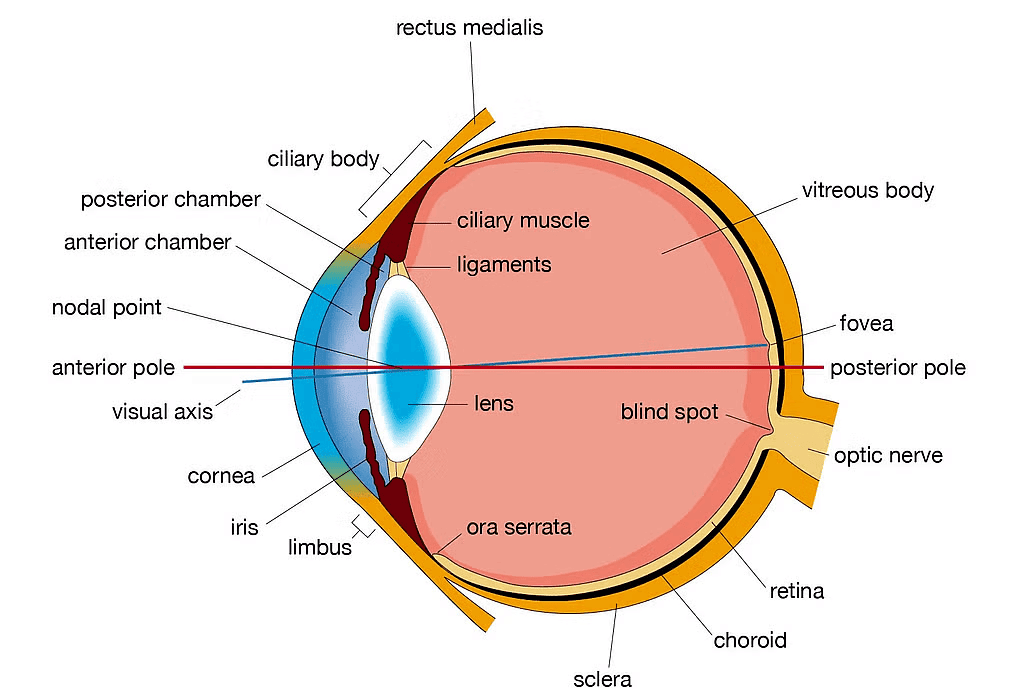
Q13: Write the function of each of the following parts of human eye:
(i) Cornea (ii) Iris (iii) Crystalline lens (iv) Ciliary muscles
Ans: (i) Cornea: It is a transparent bulge on the front surface of eyeball which refracts most of the light rays.
(ii) Iris: Iris is a dark muscular diaphragm that controls the size of the pupil.
(iii) Crystalline lens: The crystalline lens of human eye focuses the light that enters the eye and form the image on the retina.
(iv) Ciliary muscles Ciliary muscles holds the eye lens and helps in the adjustment of its focal length.
Q14: Draw a diagram of a simple microscope.
Ans: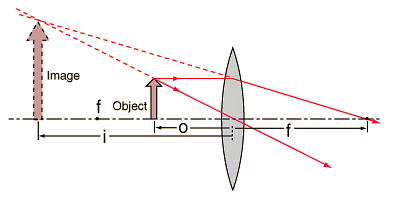
Q15: Which part of human eye helps in the perception of colours?
Ans: The retina of the human eye has a large number of cone-shaped and rod-shaped cells. 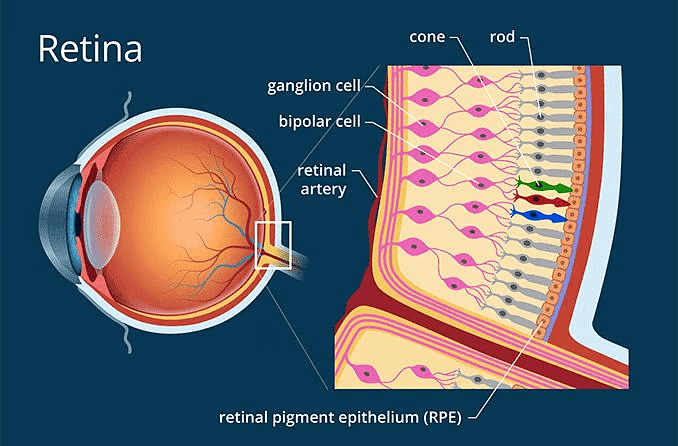 The rods respond to the intensity of light and the cones to the colours. These help us to perceive colours.
The rods respond to the intensity of light and the cones to the colours. These help us to perceive colours.
Q16: How do we see colours?
Ans: The retina of our eyes has a large number of light sensitive cells. The cells on the retina are of two shapes:
(i) Rod shaped and
(ii) Cone shaped
The rod shaped cells of our retina respond to the intensity of light. The cone shaped cells of our retina respond to colours. These cells make us see colours and to distinguish between them. Thus cones make colour perception possible.
Q17: How does an eye focus the objects lying at various distances?
Ans: An eye can focus the images of the distant objects as well as that of the nearby objects on its retina by changing the focal length of its lens. The focal length of the eye-lens is changed by the action of the ciliary muscles. The ciliary muscles can change the thickness of the eye-lens and hence its focal length changes the converging power of the eye-lens.
Q18: Explain the refraction of light through a triangular glass prism using a labelled ray diagram. Hence define the angle of deviation.
Ans: Refraction of light through prism: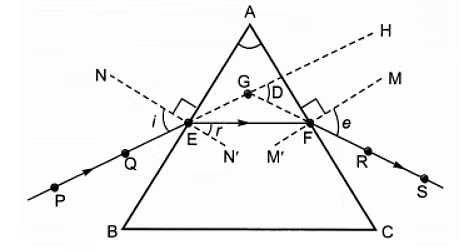 PE – Incident rayEF – Refracted rayFS – Emergent ray∠A – Angle of the prism∠i – Angle of incidence
PE – Incident rayEF – Refracted rayFS – Emergent ray∠A – Angle of the prism∠i – Angle of incidence
∠r – Angle of refraction
∠e – Angle of emergence
∠D – Angle of deviation
Refraction of light through a triangular glass prism:
- The refraction of light takes place at two surfaces firstly when light enters from air to prism and secondly when light emerges from prism.
- Angle of prism: The angle between the two lateral faces of the prism is called angle of prism.
- Angle of deviation: The angle between incident ray (produced forward) and emergent ray (produced backward).
Q19:Define the term dispersion of white light. Name the colour of light which bends (i) the most, (ii) the least, while passing through a glass prism. Draw a ray diagram to justify your answer.
Ans: Dispersion of white light by a glass prism
Dispersion: The splitting of light into its component colours is called dispersion.
The red light bends the least while violet bends the most.
Spectrum: The band of the coloured components of a light beam is called spectrum.
i.e., VIBGYOR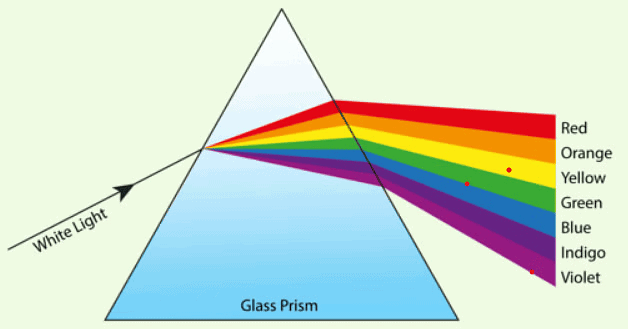 Q20: Explain clearly the working of a human eye?
Q20: Explain clearly the working of a human eye?
Ans: 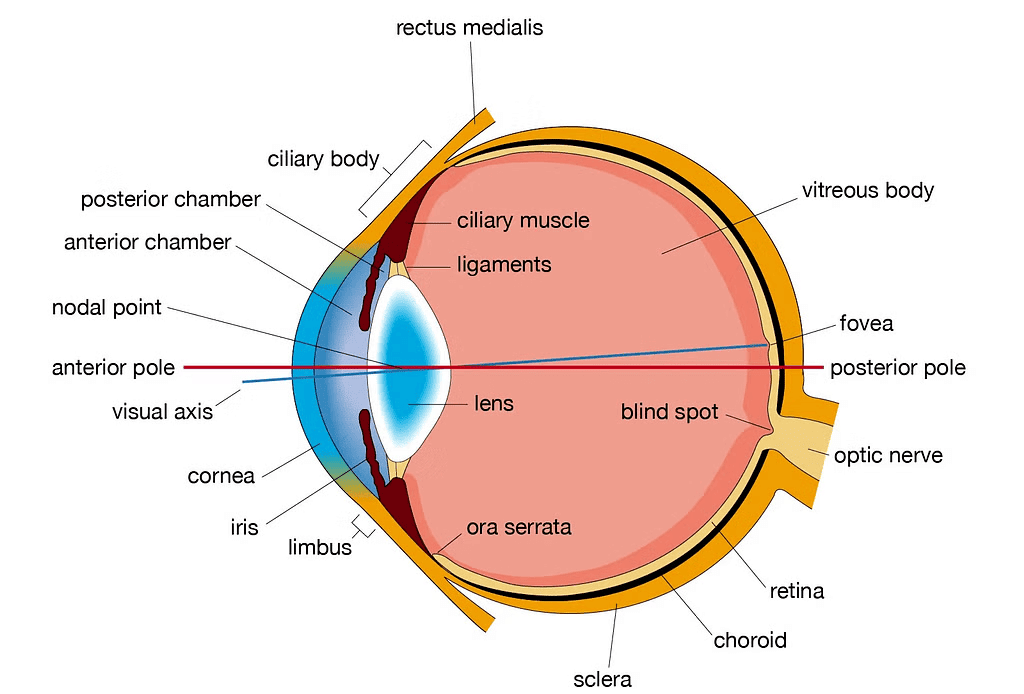 The light rays coming from the object kept in front of us enter the pupil of the eye and fall on the eye-lens. The eye-lens is a convex lens, so it converges the light rays and produces a real and inverted image of the object on the retina. The image formed on the retina is conveyed to the brain by the optic nerve and gives rise to the sensation of vision. The light-sensitive cells present in the retina gets activated and generates electrical signals. The retina sends these electrical signals to the brain through the optic nerve and gives rise to the sensation of vision. The mind interprets the inverted image formed on the retina as an erect object.
The light rays coming from the object kept in front of us enter the pupil of the eye and fall on the eye-lens. The eye-lens is a convex lens, so it converges the light rays and produces a real and inverted image of the object on the retina. The image formed on the retina is conveyed to the brain by the optic nerve and gives rise to the sensation of vision. The light-sensitive cells present in the retina gets activated and generates electrical signals. The retina sends these electrical signals to the brain through the optic nerve and gives rise to the sensation of vision. The mind interprets the inverted image formed on the retina as an erect object.
Q21: Which phenomenon of vision is made use of in cinematography? Explain briefly how it is used.
Ans: Persistence of vision is made use of in cinematography. It is the ability of an eye to continue to see the image of an object for a very short duration even after the removal of the object. We are able to see the movie pictures in a cinema due to the persistence of vision.
The still pictures taken by a movie camera are projected on the screen at a rate of about 24 pictures per second. Under these conditions, the image of one picture persists on the retina till the image of next picture falls on the screen and so on.
Due to this, the slightly different images of the successive pictures present on the film merge smoothly into one another and give us the feeling of moving images. Thus the principle of persistence of vision is made use of, in the motion picture projection in cinematography.
Q22: When is a person said to have developed cataract in his eye? How is the vision of a person having cataract restored?
Ans: 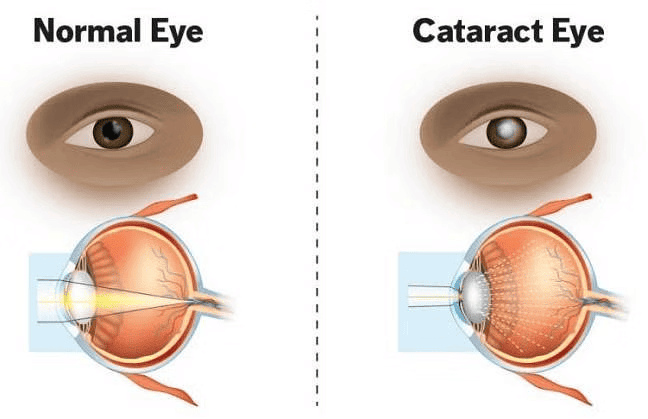 Cataract develops when the eye-lens of a person becomes unclear due to the formation of a membrane over it. The vision of a person having cataract can be restored after getting cataract surgery done on the eye-lens having cataract. This defect cannot be corrected by any type of spectacle lenses.
Cataract develops when the eye-lens of a person becomes unclear due to the formation of a membrane over it. The vision of a person having cataract can be restored after getting cataract surgery done on the eye-lens having cataract. This defect cannot be corrected by any type of spectacle lenses.
Q23: Explain the concept of a rainbow. How does the dispersion and internal reflection of sunlight in raindrops lead to the formation of a primary rainbow? Provide a detailed explanation.
Ans: A rainbow is a meteorological phenomenon that results from the dispersion, refraction, and internal reflection of sunlight in water droplets in the atmosphere.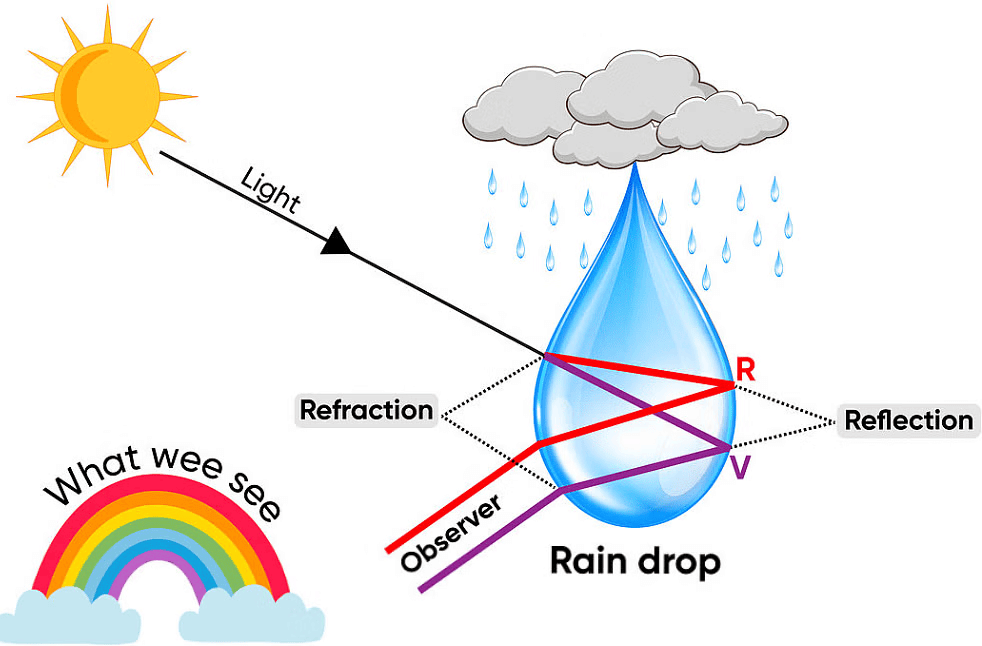 The formation of a primary rainbow involves several optical processes:
The formation of a primary rainbow involves several optical processes:
- Dispersion: Sunlight is a mixture of different colors with varying wavelengths. When sunlight enters a water droplet, it is refracted, and its colors are separated due to differences in their refractive indices. Dispersion causes the different colors to spread out.
- Internal Reflection: Once inside the water droplet, the dispersed light undergoes multiple internal reflections at the inner surface of the droplet. Total internal reflection occurs when the angle of incidence is greater than the critical angle, causing the light to bounce off the inner surface.
- Refraction: After internal reflection, the light exits the droplet and undergoes another refraction as it transitions from water to air. The refraction bends the light as it exits the droplet.
- Separation and Spectrum Formation: The combination of dispersion, internal reflection, and refraction causes the dispersed light to spread out even further. This results in the formation of a spectrum of colors, with red on the outer edge and violet on the inner edge.
- Observer's Perspective: To see a rainbow, the observer must have the Sun at their back and be facing the area where raindrops are present. The observer's eye receives the dispersed light from numerous raindrops at various angles, creating the semicircular arc of colors that we perceive as a rainbow.
The primary rainbow is the result of one internal reflection within the raindrop. The sequence of dispersion, internal reflection, and refraction working together in each droplet collectively creates the beautiful phenomenon of a primary rainbow in the sky.
Q24: Why do stars appear to twinkle ? Explain.
Ans: Due to atmospheric refraction, position of star visible from sun, is slightly different from its actual position. This apparent position of the star is not stationary, but keeps on changing with change in physical condition on earths atmosphere. Since the stars are very distant, they are approximately point-sized sources of light. As the path of rays of light coming from the star goes on varying slightly, the apparent position of the star fluctuates and the amount of starlight entering the eye flickers the star sometimes appears brighter, and at some other time, fainter, which is the twinkling effect.
Q25: Explain why the planets do not twinkle.
Ans: Planets do not emit light. However, they become visible due to reflection of light falling on them. The planets are much closer to the earth and thus can be considered as the extended source of light. The fluctuations in the light coming from various points of the planet due to atmospheric refraction get averaged out. As a result, no twinkling of planets is seen.
Q26: Explain in brief the reason for Advanced sun-rise OR Delayed sun-set.
Ans: The Sun is visible to us about 2 minutes before the actual sunrise, and about 2 minutes after the actual sunset because of atmospheric refraction. By actual sunrise, we mean the actual crossing of the horizon by the Sun. Figure shows the actual and apparent positions of the Sun with respect to the horizon. The time difference between actual sunset and the apparent sunset is about 2 minutes. The apparent flattening of the Sun’s disc at sunrise and sunset is also due to the same phenomenon.
|
80 videos|661 docs|80 tests
|
FAQs on Class 10 Science Chapter 10 Question Answers - Human Eye and Colourful World
| 1. What are the main parts of the human eye and their functions? |  |
| 2. How does the human eye perceive colors? |  |
| 3. What is the role of the lens in the human eye? |  |
| 4. What is the significance of the retina in vision? |  |
| 5. How do optical instruments enhance our vision? |  |

















